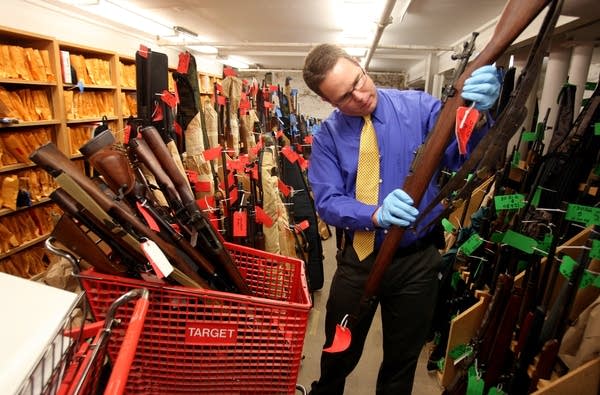To reduce gun violence, stop guns at the source
Go Deeper.
Create an account or log in to save stories.
Like this?
Thanks for liking this story! We have added it to a list of your favorite stories.

Heather Martens is executive director and Mary Lewis Grow is a board member of Protect Minnesota: Working to End Gun Violence.
In Minneapolis, Duluth and 70 cities nationwide, community members gathered Jan. 8 in solemn commemorations of the one-year anniversary of the Tucson shootings. These events followed by less than a week the funeral of three-year-old Terrell Mayes Jr., killed by a bullet that went through the walls of his north Minneapolis house as the little boy and his brother were running for cover from the too-common sound of gunfire. Later in the same week, thousands attended the funeral of Officer Shawn Schneider of Lake City, shot in the line of duty as he responded to a domestic violence call.
Yet 2011 was a year with fewer gun homicides in Minnesota than the year before. About 32 people still die every day in this country from gun homicide — about one a week in Minnesota. The toll is simply appalling. To grasp this in a way statistics cannot convey, watch the video below. It was taken at the Minneapolis event, as grieving relatives and friends read name after name.
The nationwide "Too Many Victims" vigils demanded that public officials commit to stopping these needless deaths. We must start with the source of the guns.
Turn Up Your Support
MPR News helps you turn down the noise and build shared understanding. Turn up your support for this public resource and keep trusted journalism accessible to all.
Weak U.S. gun laws play a key role in allowing access to guns by kids and others who should not have them. Easy access to guns means violence often turns lethal. A respected scholar of gun injuries and deaths, David Hemenway of the Harvard School of Public Health, compares U.S. gun deaths to those of other developed countries and shows that despite comparable rates of violent crime, our homicide rate is seven times higher than those of comparably developed countries. This is driven by a firearms homicide rate that is 20 times higher.
The difference, Hemenway points out, is gun laws. Even in those countries such as Canada where gun ownership rates are high, it's much less likely that unsuitable people will get guns and take lives with them, thanks to background checks, training requirements, waiting periods and limitations on high-capacity magazines. Minnesota has a partial background check requirement; people buying from licensed dealers must get background checks, though buyers from individuals at gun shows need not.
The Minnesota Legislature has failed to close this "gun show loophole," even though the ATF has reported that gun shows are a "major trafficking channel." Some argue that criminals get guns no matter what, but that's not the case. All guns start out legal. The way guns get to the streets is through legal private sales, gun trafficking and theft. New York City has successfully shown that interrupting gun trafficking makes guns less available on the streets.
We would support a bill making gun trafficking illegal under state law, not just federal law. The ATF, leaderless for years and understaffed, needs more help from local authorities. There is broad agreement that we should "enforce existing gun laws." So let the Legislature actually help make it happen.
What must stop is the effort in the Legislature this year to ram through several gun bills that appeal to the extremes and decimate our existing gun laws in order to expand the gun market. This year's efforts include:
A constitutional amendment to rearm violent criminals and domestic abusers, and open up the state to expensive lawsuits under the guise of a "right to bear arms."
A bill to legalize the sale of silencers by gun dealers — making silencers more widely available and profitable for gun dealers.
A bill to legalize the shooting of another person, anywhere, as a first resort if the shooter feels threatened; and to create a legal presumption that the killing of any trespasser, even a nonthreatening and unarmed one, is justified. This would expand the market for "self-defense" gun instruction by dispelling any fear of being held responsible for one's actions with a gun.
A bill to allow any person with a carry permit from another state — no matter how weak or poorly administered that state's law — to carry a loaded gun in public in Minnesota. This would be a bonanza for gun traffickers.
A bill to arm prosecutors in courthouses. This bill would begin to absolve public courthouses — and the sheriffs' departments that currently provide security — of responsibility to ensure public safety through the only rational means, weapons screening. Instead, it would deputize prosecutors and assistant prosecutors to be their own security detail.
The sad truth is that more guns in more hands doesn't lead to more public safety. The National Academy of Sciences, after an exhaustive review of the data, found in 2004 that making concealed carry permits available to more people does nothing to improve public safety. But interrupting gun trafficking does. Let's resolve this year to act where the common ground is.




